The Crystal Maze: Inside the new zones
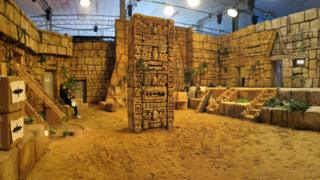
The Crystal Maze returns to our TV screens on Friday night, more than 20 years after the last full series ended.
Richard Ayoade is fronting 20 new episodes - five of which will be celebrity specials and one a Christmas special.
The show has huge nostalgia value and has developed a cult following thanks to TV repeats - which explains why more than 30,000 people applied to take part in the new series.
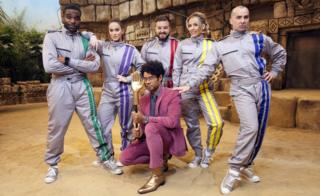 Image copyright
Channel 4
Image copyright
Channel 4
All of the 41 games featured in the rebooted series are new, but the four zones remain the same.
Fans will recognise the Medieval, Industrial, Aztec and Future areas - but the sets had to be rebuilt from scratch for the new show and one zone in particular has had a major refurb (more on the zones in a minute).
There was really only one person for the job when it came to building the new sets - the show's original designer James Dillon.
Fortunately, Channel 4 still had his number. And Dillon, in turn, still had a lot of his original drawings and sketches from the first series, which ran from 1990 to 1995.
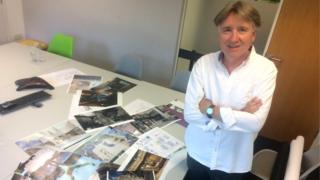
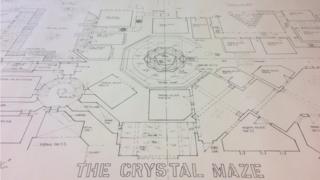
"This incarnation of the show came about because there's been so much interest in The Crystal Maze over the years," Dillon tells the BBC.
"It's become a cult show. It's repeated endlessly on TV and so it has a whole new generation of fans from the original series. And a couple of years ago there was a crowdfunding campaign to build a Crystal Maze as a live experience in London.
"That was done by a separate company and didn't have anything to do with me, but I think that sort of sparked people's interest enough to have caused the Stand Up For Cancer special that Channel 4 did last year.
 Image copyright
Channel 4
Image copyright
Channel 4
"They went to the live experience site and recorded that episode there, and that was transmitted and was extremely successful in the ratings. And from the fans' point of view, I think people really liked that the Crystal Maze was being resurrected.
"I wasn't involved in the shooting of the special but I believe there are great difficulties in shooting the show in that space. It's not designed for television, so getting the cameras in and around all the sets and into the games and generally in the zones was very difficult.
"So as a result of that, Channel 4 were keen to see if they could explore doing a full-scale version of the Crystal Maze, bring it back, and that's when I got involved.
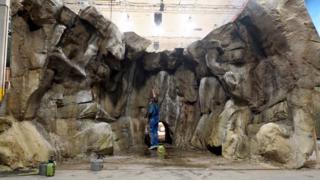
"The producers asked me to come in with whatever drawings I had of the original sets and talk them through how we did it, and just explain what the upsides and downsides would be of building a new one. And building a new one was exactly what we ended up doing."
Let's take a look over the four zones and how they've been rebuilt - from floor plans, sketches and models through to the finished sets.
The Medieval zone
 Image copyright
Channel 4
Image copyright
Channel 4
"The idea behind Medieval was to create the feel of a rather frightening dungeon," Dillon says.
"It's quite dark, very moody, lots of atmosphere. There are something like 200 candles and 15 flaming torches that light it all up."
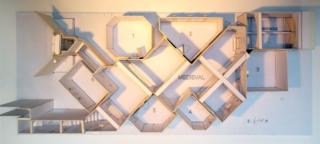

"We've also for this series created a much more realistic-looking floor," he adds.
"I think the original one was just a painted floor on an aircraft hangar with some straw over it, but it's now a completely flagstone floor which makes it feel a bit more real and locked together.
"And that goes into the games rooms as well, so everything feels of apiece."
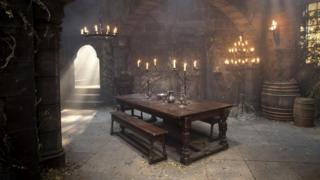 Image copyright
Channel 4
Image copyright
Channel 4
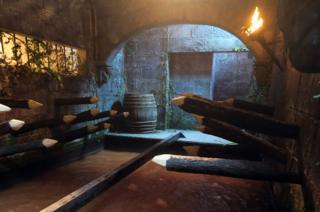 Image copyright
Channel 4
Image copyright
Channel 4
The Future zone
"The future zone is very different to what it looked like originally," Dillon says.
"Firstly, we've increased some of the gameplay rooms to bigger sizes in order to make the games feel a bit more spectacular, a bit more special. The extra space allows for games which are far more physical and have a bigger scale than before.
"But I also wanted to get away from the original look, which was a slightly broken down and dystopian vision of the future. Now the vision is very clean, pristine, quite antiseptic - it's like the neighbourhood has come up a bit."
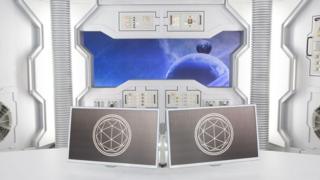 Image copyright
Channel 4
Image copyright
Channel 4
Unlike the other three zones, which have changed little, Dillon says he used special software to create the new Future zone from scratch, which meant no paper sketches or cardboard models were needed.
"Computers have come a long way and computer-aided design (CAD) is now standard in film and TV design.
"So Future was designed using CAD software which meant we could see the rooms in 3D before we actually built them.
"The CAD drawings were then sent to the workshop and were used to build the set, so it cuts out a whole step of the process and makes it a lot easier and quicker to do."
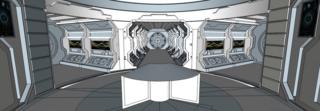

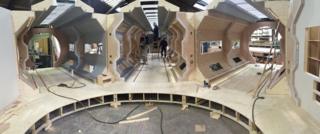

 Image copyright
Channel 4
Image copyright
Channel 4
He adds: "We've incorporated a lot of LED lighting and LED screens into Future which will have visuals playing on them.
"All of the zones are quite epic and quite filmic in terms of the size of the sets, and that's really exciting - to work on something of that scale.
"But it's also quite worrying, because what's involved is a lot of people and a lot of time and money, and it's all a countdown to the thing being filmed so the pressure can be high to get everything ready and working on time."
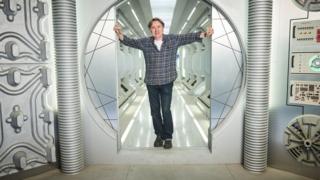
The Industrial zone
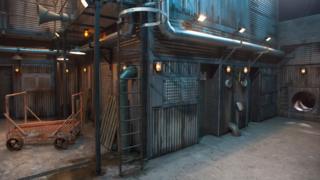 Image copyright
Channel 4
Image copyright
Channel 4
"Industrial's quite interesting because it's almost like a period set now," Dillon says.
"There's so few elements from the original in daily life now. So much industrial landscape has disappeared, we don't do industry so much in this country anymore."
"So its almost like a period thing now that you look back on and go, 'oh yes, that's what it used to be when you went to a factory or an industrial landscape.'"
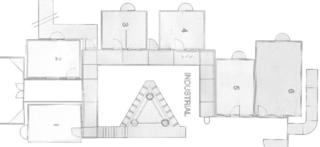
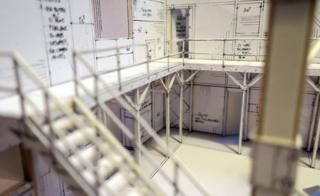
"In the new space what we were able to do with Industrial was incorporate elements of the existing studio space where we were filming into the set, so it makes it feel a much bigger and wider space than it was originally.
"We knocked down some walls and we were able to get far more interesting crane shots and camera shots of the feel of an industrial place.
"Where we're shooting is, in essence, a factory, so we were able to fold some of those factory elements into the set."
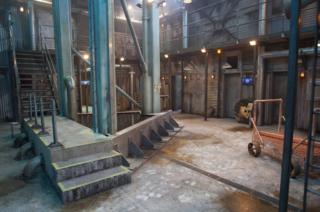 Image copyright
Channel 4
Image copyright
Channel 4
The Aztec zone
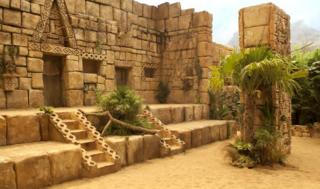 Image copyright
Channel 4
Image copyright
Channel 4
"This is meant to look like an abandoned Aztec temple," Dillon explains. "Within it there's a lot of sand - we've got something like 18 tons of sand on the floor.
"We've also got 200 or so plants to create a jungle, some real, some artificial.
"One of the problems is you're shooting three or four weeks on a darkened stage, and the plants would die if you're not careful. So we have some which are artificial and the real ones we take out of the studio at the weekend to let them get some light and water."
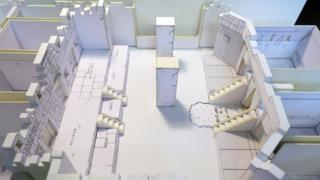
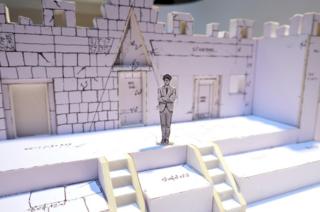
"The Aztec zone was quite labour-intensive. It took almost three weeks to build it up because it's almost brick-by-brick.
"After the building stage, there comes a painting stage. So it's basically without colour, and then the painters add the colour and texture to it, so that it has the right design for a temple.
"We've altered the finishes so it's much more detailed. The original set was done a number of years ago, and the quality of cameras in those days wasn't so good.
"We're now talking about high definition large TVs which everybody has in their house. So we've had to try and make sure that everything on set is as high quality as it can be. We can't get away with any cheap and cheerful tricks anymore."
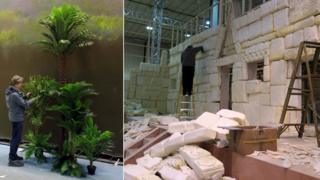
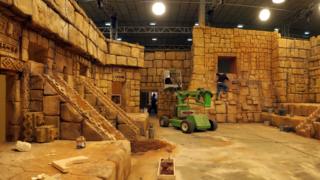
The Crystal Dome
Dillon says: "This is the only thing on the original set that was designed by computer, because it's a geodesic dome - a sphere made up of triangles - and they're very difficult to draw and visualise.
"This time around, we've done away with the moat around the dome and gone for a much more contemporary feel. We've redesigned the fan system and used LED lighting, so there are almost as many lights as you'd get at a concert."
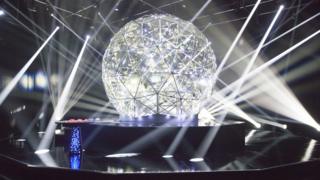 Image copyright
Channel 4
Image copyright
Channel 4
A logistical issue caused by the dome's close proximity to Aztec has also resulted in it being built on a different stage to the other zones.
It means the dome is no longer actually located in the centre of the four zones, as it appears in the on-screen map.
"One of the problems with the dome was the sand from the Aztec zone," Dillon says.
"It gets quite dry, quite dusty in Aztec, the whole studio gets covered in dust. We had particular problems with the Crystal Dome because there are fans inside it that would suck the sand and dust up into it.
"It was a nightmare job cleaning it and keeping it sparkling, but because we've taken the dome into another studio this time, it's easier to control it."
A wise decision if you ask us. We wouldn't have much fancied cleaning out all that sand either.
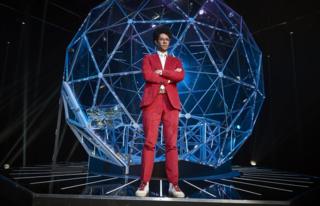 Image copyright
Channel 4
Image copyright
Channel 4
The Crystal Maze launches on Channel 4 at 21:00 BST on Friday 23 June.
Follow us on Facebook, on Twitter @BBCNewsEnts, or on Instagram at bbcnewsents. If you have a story suggestion email entertainment.news@bbc.co.uk.
